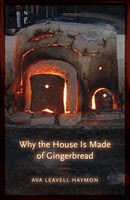
One of my favorite stories was “Hansel and Gretel.” Now I know a lot of right-thinking people frown on fairy tales like “Hansel and Gretel, ” but it made good sense to me then, and still makes good sense to me now. Two children get lost in the woods, find a gingerbread house, do what any hungry child would do and eat a piece, and get imprisoned by the wicked witch, who plans on doing what wicked witches always do, and that’s to eat them. Hansel is kept in a cage to fatten him up, and Gretel is worked to the bone, until she eventually seizes the opportunity to push the witch into the oven. Yes! Good triumphs over evil! The wicked witch is burned to a crisp!
Poet Ava Levall Haymon has taken the story of Hansel and Gretel and turned it into an extraordinary series of poems in Why the House is Made of Gingerbread: Poems. Together, the poems form a significant retelling of the story, but one that remains true to the original. It is the story of Gretel, and contemporary housewife and mother, who finds herself absorbed into the fairy tale and living the story of the child Gretel.
Haymon weaves an amazing tale, and the transition to the fairy tale starts gradually. From the poem “Autobiography:”
Gretel’s attention disengages from her driving
and she is the young girl in the dark
beside Hansel’s cage, legs aching from standing
since before dawn. Gretel squeezes
the wheel, shoulders tight, longing
to trade places with her brother,
for his ignorance of minding the fire,
hauling water with bruised fingers,
his freedom from the danger of failure – one slip
of the girl’s memory in a recipe, one broken dish
and there’s no story, just another couple of kids
who never came home. A ruckus breaks out
in the back seat, and Gretel shudders back
into the present, driving kids to school.
She presses the brake hard: That didn’t happen!
But it did happen and it does happen, and soon she finds herself the original Gretel, captive with her brother by the witch, with their doom creeping ever closer. From “The Witch Has Told You a Story:”
You are food.
You are here for me
to eat. Fatten up,
and I will like you better.
Your brother will be first,
You must wait your turn.
Feed him yourself, you will
Learn to do it. You will take him
Eggs with yellow sauce, muffins
Torn apart and leaking butter, friend meats
Late in the morning, and always sweets
In a sticky parade from the kitchen…
Haymon guides her Gretel into a gradual identification with her captor, wnile her brother turns into something fattened up for dinner. But the story is told true to the original, and it’s the witch who meets her doom, even if Gretel will carry some of that witch with her, and back into her real housewife life.
Haymon, who teaches poetry writing and directs a writer’s retreat in New Mexico, is the author of two previous collections, Kitchen Heat and The Strict Economy of Fire. In Why the House is Made of Gingerbread, she has creatively translated a fairy tale into both a faithful and imaginative retelling and a modern story, its own fairy tale.
- Poets and Poems: Beth Copeland and “I Ask the Mountain to Heal My Heart” - July 10, 2025
- A.E. Stallings: the Parthenon Marbles, Poets, and Artists - July 8, 2025
- Poets and Fables: Steven Flint and “The Sun and the Boy” - July 3, 2025

L. L. Barkat says
Oh my gosh, I love these. (Putting it on my Amazon wish list right now 🙂
Hey, I think we had the same Grimm’s btw 🙂
Maureen Doallas says
L.L. beat me to the words.